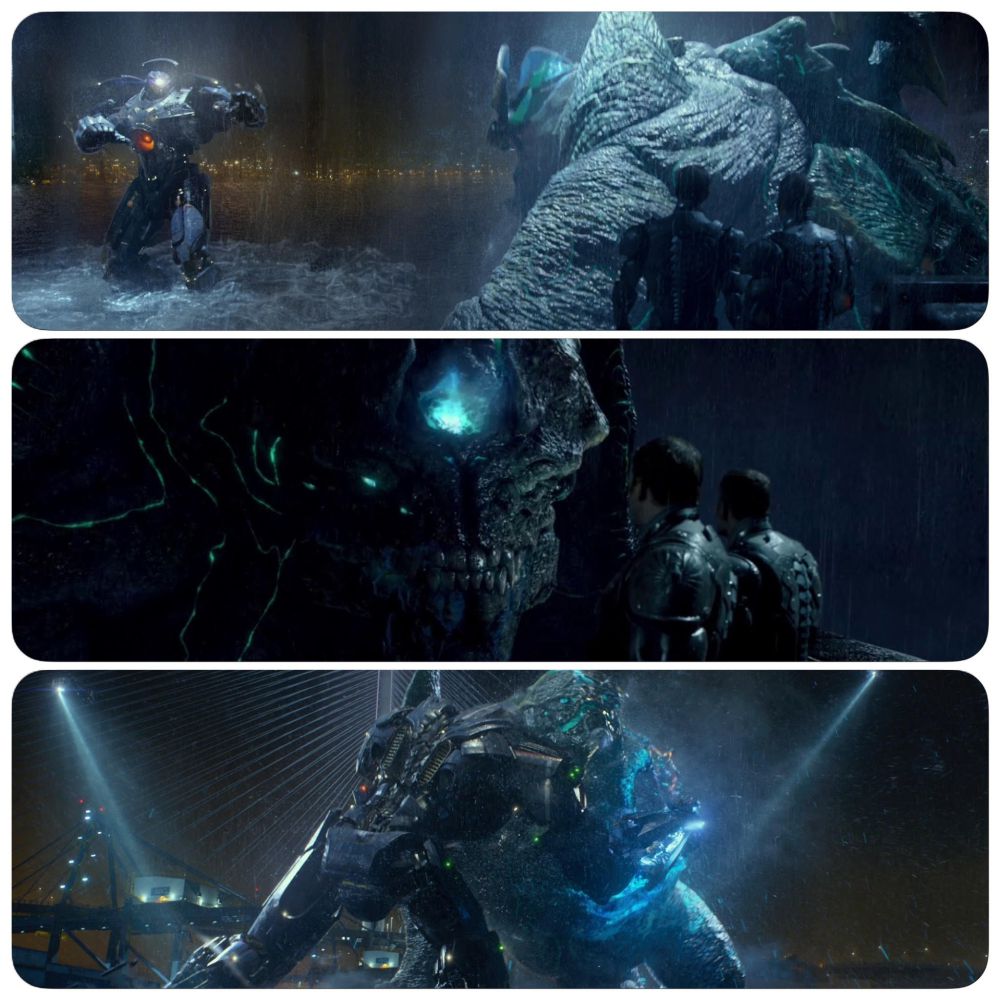Once upon a time, there was a Hollywood pitch session where somebody in a suit commanded a bunch of other people in suits to offer ideas for the studio’s next big blockbuster. One by one, the hapless suits throw out one idea less interesting than the last, and as the mood of the meeting turns from frustration to anger to desperation, the suit in charge finally howls through clenched teeth that somebody better cough up a winning idea or everybody’s fired. And that’s when Guillermo del Toro kicked in the door, threw some action figures of robots and monsters onto the table and let a few 8-year-olds play with them. And as the kids PSSH KAPOW RAWR SHOOM SHOOMed their way through the imaginary battle that ensued, the suit in charge narrowed his eyes, smiled, and ordered somebody to write del Toro a check for $190 million so he could make a two-and-a-half-hour epic about giant robots and sea monsters fist-fighting each other. That might not be exactly how Pacific Rim got greenlit, but why let the truth get in the way of a good story?
Pacific Rim takes place not too far in the future, after a dimensional rift at the bottom of the Pacific Ocean has admitted skyscraper-sized monsters called kaiju into our world. Humanity builds a fleet of equally enormous humanoid robots called jaegers to battle the kaiju, and for a while, the world’s nations unite and throw everything they have into this effort. But eventually, the kaiju prevail, and by the time our story begins, the jaeger initiative has been abandoned in favor of building a massive defensive wall to protect all coastal cities. Everybody knows the wall will fail, so a ragtag band of pilots are recruited to pilot the few remaining jaegers on a suicide mission to seal the dimensional breach with a nuclear weapon. But as they put this plan into motion, they manage to link their minds with those of the kaiju, and learn that simply bashing up coastal cities is just the first phase of the kaiju’s plan…and that the monsters humanity has battled so far are just the smallest yet to enter the fight.
You don’t have to be a little kid to enjoy Pacific Rim, but it sure does help. This is the kind of movie that speaks to that part of us that never stopped playing with toys, has argued extensively on whether Ultraman could really beat King Kong, and has welcomed the modern era of CGI movie-making as the extended love letter to geek culture that it is.
So no, Pacific Rim isn’t great cinema. It’s not a particularly inventive premise or compelling narrative with fascinating characters. Heck, it’s not even that expertly executed, which is a surprise, given that Guillermo del Toro directed it. After all, if humanity has helicopters strong enough to airlift giant jaegers into battle, why bother building giant robots? We clearly have chopper engines up to the task. Or, if one of the jaegers has a sword capable of cutting a kaiju in half, why aren’t all of the jaegers equipped with the same weapon? Or why, if the world has united to pool its resources to fight these unstoppable monsters, hasn’t it also evacuated its biggest coastal cities? And why do jaegers need to be piloted by two people at once, other than to provide us with a reason for the various jaeger pilots to appear in the same scenes together? It’s a weird plot device, and ends up making the pilots look like they’re trying to win a game of partner Dance Dance Revolution more than battle giant monsters.
And yet, the magic of this movie is that if you have bothered to see it at all, you’re not going to care about such glaring plot holes, of which those mentioned above are simply the most egregious. No, the basic proposition of Pacific Rim—gorgeously rendered CGI mecha engage in all kinds of mortal combat against equally well-rendered CGI kaiju—is such fanservice to a particular audience that things like plot and character only get in the way.
This has been the central problem with kaiju movies, historically—nobody has the budget to show monsters destroying cities and fighting each other for a full 100 minutes, so they must always involve long scenes of humans talking about the problem while the audience screams at the screen to quit with the yakking and get back in your tank or superjet or mecha suit or whatever and take business already. And to the extent that it can, Pacific Rim delivers in that department repeatedly. There are inevitable side plots over our heroes figuring out how to best work together, enlisting a black market kaiju organ dealer to literally read the mind of the enemy, and shrugging off orders to cease fighting altogether and cower behind a wall. And for a monster movie, those are all fairly entertaining. They’re not jaegers putting super-buzzsaws to sea monsters, but they work.
The moment of truth comes in the middle of the movie, during a heroic battle that seems to destroy more of the city than it saves, thanks to the extreme collateral damage that results when robots and monsters duke it out. When all looks lost, our heroes stride onto the scene, dragging an oil tanker behind them and use it like a giant baseball bat to bash a kaiju over the skull. If you ever had any doubts about the movie, that’s when they dissolve. It’s a statement of intent so far beyond the realm of adulthood that we have no choice but to stand up and scream for the jaeger to hit that kaiju again, and this time, maybe find an ever bigger boat. Hell, use a skyscraper. Use a bridge. Just don’t stop. For the love of everyone who ever watched men in rubber monster suits stomp on models of Tokyo…don’t stop. We’re having too much fun.






